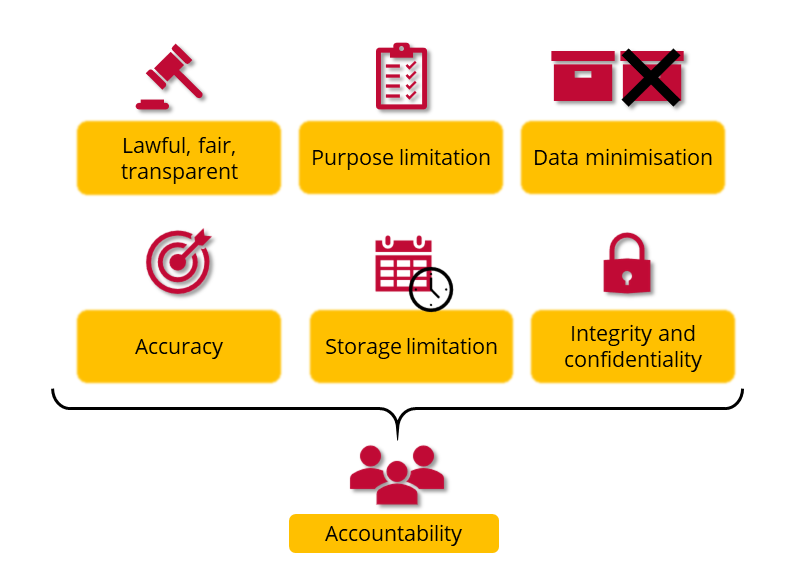Principles in the GDPR
On this page: legal basis, legal ground, fair, transparent, purpose, goal, aim,
minimise, accurate, storing, storage, safeguards, measures, responsible,
responsibility
Date of last review: 2023-07-11
The GDPR has a number of principles at its core which dictate the (method of) data processing. Every type of processing has to comply with these principles. Understanding these principles is the first step to determining what type of personal data can be collected and how they can processed.
The GDPR principles are explained further below the image. The Design chapter describes how to implement these principles in your research. You can also always contact your privacy officer.

1. Lawful, fair and transparent
When working with personal data, your processing should be:
-
Lawful
Make sure all your processing activities (e.g., data collection, storage, analysis, sharing) have a legal basis. Ideally, you should have determined your processing purposes (e.g., research questions) in advance.
-
Fair
- Consider the broad effects of your processing on the rights and dignity of the data subject.
- Give data subjects the possibility to exercise their rights.
- Avoid deception in the communication with data subjects: processing of personal data should be in line with what they can expect.
- The processing of personal data should not have a disproportionate negative, unlawful, discriminating or misleading effect on data subjects.
-
Transparent
Be transparent in the communication to your data subjects about who is processing the personal data (controllers, processors), which personal data are processed, as well as why and for how long, and how data subjects can exercise their rights. The information provided should be unambiguous, concise, easily accessible and relevant and shared with data subjects before the start of your research.
2. Purpose limitation
You can only process (i.e., collect, analyse, store, share, etc.) personal data for a specific purpose and only for as long as necessary to complete that purpose. For example, if you communicated to data subjects that you would use their personal data only to answer your specific research question, you cannot further share the personal data for new research questions, as these would be additional processing purposes. This means that you need to plan what you will do with the (collected) personal data in advance and stick to that plan in order to be GDPR-compliant.
3. Data minimisation
You can only process the personal data you need to for your predefined purpose(s), and not more just because they may “come in handy later”. This principle makes sure that, for example, in the event of a data breach, the amount of data exposed is kept to a minimum.
4. Accuracy
The accuracy of personal data is integral to data protection. Inaccurate data can be a risk for data subjects, for example when they lead to a wrong treatment in a medical trial. You therefore need to take every reasonable step to remove or rectify data that is inaccurate or incomplete. Moreover, data subjects have the right to request that inaccurate or incomplete data be removed or rectified within 30 days.
5. Storage limitation
You can only store personal data for as long as is necessary to achieve your (research) purpose. Afterwards, they need to be removed. If the personal data are part of your research data (and not, for example, to simply contact data subjects), you are allowed to store (archive) them for a longer period of time, provided necessary safeguards are in place. This is an exemption that applies to data storage for scientific archiving purposes. You need to inform the data subjects on this storage duration beforehand.
If identification of the data subject is no longer needed for your (research) purposes, you do not need to keep storing the personal data just to comply with the GDPR, even if it means your data subjects cannot exercise their rights (art. 11).
6. Integrity and confidentiality
You have to process personal data securely and protect against unauthorised processing or access, loss or damage. To this end, you should put in place apropriate organisational and technical measures.
7. Accountability
The controller is ultimately responsible for demonstrating GDPR-compliance. As a researcher working with personal data, you are representing your institution (e.g., Utrecht University) and you should therefore be able to demonstrate that you process personal data in a compliant manner. Additionally, you should also have some knowledge of data protection so that you can implement the right measures into your research project.